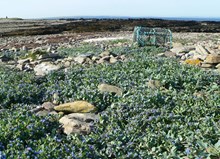14 August, 2014
New report finds Scottish shingle thriving
A report published today finds that there are more vegetated shingle beaches in Scotland than previously thought – and most of them are in good condition.
Until recently, the information on shingle habitats in Scotland was limited. But a new Scottish Natural Heritage (SNH) report finds there are about 1,120 hectares – or the equivalent of more than 1,500 football pitches – of shingle beaches with vegetation in Scotland.
Shingle coastlines are a distinctive feature of the Solway and Moray Firths and the Isle of Arran, as well as on scattered sites around the coast of Scotland. Outside of north-west Europe, Japan and New Zealand, shingle beaches are found only in a few places world-wide.
Vegetated shingle supports a variety of plants and animals, with some highly specialised species adapted to tolerate harsh coastal conditions. Typical plants include the oysterplant and sea kale, both of which are nationally scarce. A rich array of lichens can also be found on stable, undisturbed, shingle further inland.
Some species of invertebrates also favour shingle habitats, such as the black zipper, sand bear spiders and a number of rove beetles. A range of bird species also use shingle habitats, including terns. The importance of this habitat for breeding terns has led to several conservation designations.
Vegetated shingle is protected under the EU Habitats Directive and about 20 shingle sites in Scotland are protected under national legislation.
Rebecca O’Hara, SNH habitats officer, said:
"Coastal shingle is internationally rare and is an important and unique part of Scotland’s nature. Powerful waves form these beaches, which host a fascinating variety of plants and animals in what may seem to be inhospitable conditions. Because of this, we were really pleased to find that shingle habitat is doing so well. Scotland's remote and relatively untouched coasts provide some of the best conditions in Europe for vegetated shingle.
“This new survey adds to our growing knowledge of habitats of European importance in Scotland, and will be part of a new habitat map which SNH is developing."
To download the full report, see http://bit.ly/VmzEdf .
Contact information
- Name
- SNH Media
- snhmedia@snh.gov.uk
NatureScot is Scotland's nature agency. We work to enhance our natural environment in Scotland and inspire everyone to care more about it. Our priority is a nature-rich future for Scotland and an effective response to the climate emergency. For more information, visit our website at www.nature.scot or follow us on X at https://x.com/NatureScot
’S e NatureScot buidheann nàdair na h-Alba. Bidh sinn a’ neartachadh àrainneachd na h-Alba agus a’ brosnachadh dhaoine gu barrachd suim a chur ann an nàdar. Tha e mar phrìomhachas againn gum bi nàdar na h-Alba beairteach agus gun dèilig sinn gu h-èifeachdach le èiginn na gnàth-shìde. Tha an tuilleadh fiosrachaidh aig www.nature.scot no air X aig https://x.com/NatureScot



